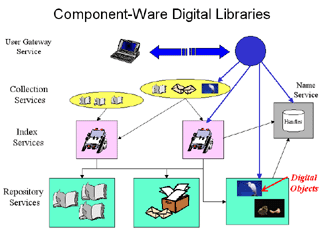THDL Toolbox > THL Technologies & Open Standards > Technologies For Dummies > FEDORA
What is FEDORA?
Contributor(s):

For technical documentation of FEDORA, see the  main Fedora site.
main Fedora site.
Simple Introduction to FEDORA
The Tibetan and Himalayan Digital Library is based upon an powerful digital library initiative spearheaded by the University of Virginia and Cornell University to build a comprehensive and powerful digital library infrastructure based upon the FEDORA protocol. FEDORA ("Flexible Extensible Digital Object Repository Architecture"), is a protocol for a digital library system designed by the Digital Library Research Group at Cornell University, and first implemented by the University of Virginia Library's Digital Library Research and Development Dept. This led to the Mellon-funded full development of the system by Virginia and Cornell, with a consortium of institutions agreeing to test it, including Oxford University, King's College London, New York University, Indiana University, Tufts, and the Library of Congress.
The basic model is of integration and flexibility using a modular, open-system, standards-based, and object-oriented design. Rather than disparate web resources using different systems, it integrates various media and database resources into a single integrated architecture allowing maximum flexibility, scalability, and interoperability. This entails powerful searching facilities across different resources, standard interfaces, and general built-in interoperability. This is reinforced by using standard classification systems across the entire library, and accessing uniform collections, references and tools. The data and resources contained by the digital library are extremely flexible; instead of being locked into one software system, or one style of presentation, all resources – whether a text, a map, image, video, audio recording or database record – sit in the system as independent, discrete objects. These objects then can combined and detached from each other in accordance with different software functions and needs. Finally, there are built in tools to allow for the generation of user-defined collections.
This work is being done by the Digital Library departments. at Cornell and UVA, though certain facets are designed and implemented in collaboration with THDL staff. THDL has been the driving force behind supplementary software and procedural systems that build upon FEDORA to build a full adaptation of it for the needs of an area studies-based digital library system serving an international array of creators and users operating from diverse disciplinary and linguistic bases. While our particular focus is providing an integrated publishing environment for the multitude of Tibet and Himalayan-oriented projects from around the world, we are also aiming to develop a general model that can be utilized by other area studies initiatives as well that goes from field data collection to integrated dissemination of scholarship and data across the world over the Web. THDL in coordination with other centers is taking responsibility for five distinct realms of technical and intellectual development to adapt the FEDORA model into a fully functional and comprehensive area studies digital library system:
- Digital Ethnographical system: a comprehensive set of databases, tools, and documentation for collecting original knowledge in the form of images, video, audio, interviews, scholarship, texts, measurements, maps, GIS readings, and other data on location in the field in ways that ensure adequate documentation and easy migration back into the Digital Library.
- Collaborative Knowledge Interface system: an integrated technical, intellectual and organizational process for participants from around the world to work simultaneously on joint resources down to the most granular of levels, yet retain individuated crediting, the ability to edit only one's own submissions, and a capacity for automated on-the-fly organized and comprehensible presentations of data at all points.
- Pedagogical E-folio collaborative classroom system: an on-line system fully integrated with the Digital Library allowing students to create Web pages on-line and in three dimensional exhibition halls, including the direct use and incorporation of digital library resources, students to comment on each other's work, and instructors to post assignments, resources, and comments on student work.
- Adaptation for Himalayan languages and script: to enable all facets of the Digital Library to accept and display Tibetan script data over the Web, provide automated switching between transliterated Tibetan and phonetically rendered Tibetan, provide a multilingual interface for English- and Tibetan-speaking users, enable sorting according to the Tibetan alphabet, and enable parsing and glossing of Tibetan texts even for users with no knowledge of the Tibetan language; this requires a provisional non-Unicode solution already implemented, and support of an initiative to fully enable Tibetan Unicode fonts. Our merging with Digital Himalaya and collaboration with Cornell University now demands that we focus new attention on the use of Devanagari, the dominant script in use in Nepal and other areas of the southern Himalayas.
- Adaptation of data structures and programs for Tibetan and Himalayan Studies and cultures: to build the data structures precisely adapted to the needs of an area studies initiatives combining multiple languages and multiple cultural interpretive frameworks, such as the "Savant" system for integrating ethnographic videos and transcripts, a SGML/XML document type definition called Tibbibl built specifically for representing Tibetan literature, an OED-style rich dictionary, and so on.
How is FEDORA being used in THDL?
TBA.
How Can I Explore FEDORA Further?
TBA.
Provided for unrestricted use by the  Tibetan and Himalayan Digital Library
Tibetan and Himalayan Digital Library